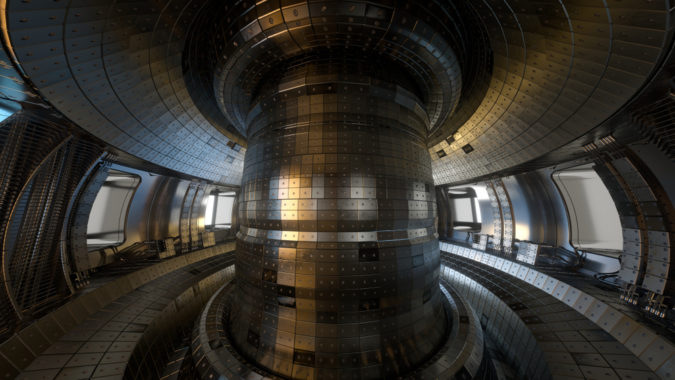As HPC and AI continue to rapidly advance, the alluring vision of nuclear fusion and its endless zero-carbon, low-radioactivity energy is the sparkle in many a futurist’s eye.
At an ISC focus session, attendees were given an overview of digital twin efforts toward fusion in the U.K. by Rob Akers, Director of Computing Programs, U.K. Atomic Energy Authority (UKAEA).
Akers spearheads a team of physicists, data scientists, AI and ML experts, and HPC specialists guided by the mission to enable commercial fusion energy by the early 2040s – a timeline that Akers says will be quite challenging.
“We simply don’t have time to deliver fusion against the timeline we’ve been given using test-based design,” he said, adding that the answer lies in exploiting the “enormous power of data science and supercomputing at scale.”
Tokamaks, or the experimental machines designed to harness the energy of fusion, are highly complex and strongly coupled with multiple physics mechanisms: radiation, electromagnetism, structural forces and gravity, heat transport, chemical transport, and temporal coupling.
“It’s a multi-scale, multi-physics, system of systems grand challenge, and as a dynamic system, it’s absolutely inevitable that there’s going to be a lot of emergent behavior across the plant,” said Akers, and in a nod to the recent Oscar-winning film, he added, “In other words, we’ve got to be able to simulate everything, everywhere, all at once.”

Digital twins hold the promise of solving these immense simulation needs. Akers says we are nowhere near being able to simulate a fusion reactor just yet, so his team is starting with simulating simple thermohydraulic test rigs. These simulations are designed to simulate disruptions, or the losses in magnetism and thermal energy that occur when tokamak plasma becomes unstable.
Akers showed a Venn diagram of simulation projects aimed toward building a full plant digital twin spread between the categories of plasma simulation, materials simulation, and plant/engineering simulation.
The first simulation Akers highlighted concerns where the plasma meets the first wall of the tokamak. Crucial physics properties have been missing in the quest to build a high-fidelity simulator for this purpose, Akers noted, due to the lack of exascale computing power needed until recently. Through an initiative called Excalibur, the researchers are building software code through proxy apps.
“Plasma is a complicated problem from a fluid dynamics standpoint because it is not Maxwellian – we have to actually model velocity space.” The current model has five dimensions, two in real space and three in velocity space where researchers are simulating filaments that burst from the edge of the plasma. The calculations for this are enabled by NEKTAR++, a spectral/HP element framework that has been traditionally used in the aerospace sector.
Addressing the programming tools they are using, Akers said: “We’re doing all the things we should be doing with a modern code. We’re building in the verification right from the get-go. We’re making sure that the code is easy to develop for the people that aren’t the HPC specialists.” Akers also mentioned the need for the code to be performance portable, so it is encoded in the SYCL programming language: “At the moment, we don’t know what the UK first exascale machine is going to be in terms of architecture, we hope that SYCL will allow us to use it. And we’re working on things like the preconditioning methods.”
With all they are doing, the design is still “not anywhere near fast enough” for engineering design. So they’ve started looking at the machine learning methods to provide “an initial first guess and reduce the number of GMRES iterations that the code is going to require.”
The team is working with Caltech and Nvidia to develop a novel FNO architecture to handle multivariable modeling which is tested extensively to model the diffusion of multiple plasma blobs under the influence of magnetohydrodynamic instabilities using a program called JOREK.

Another project is simulating the CHIMERA test rig, a machine for testing fusion energy components housed at UKAEA’s Fusion Technology Facility in South Yorkshire. This simulation uses the MOOSE framework, a framework developed by Idaho National Laboratory that uses libMESH as its finite element library and PETSc as the nonlinear solver.
The team is working on the simulation’s speed with HPC: “We’re within a gnat’s whisker of having a real time system, so we’re about a factor of 15 away from being faster than real time,” Akers said dryly. “But there’s a lot we can do. We’re starting to look at the GPUs. We’re starting to look at potentially swapping out libMesh with MFEM and potentially looking at Hyper instead of PETSc. Or maybe we can get PETSc working efficiently enough to get the speed up that we need.”
He continued: “But even again, with these things, we’re probably not going to be faster than real time on the number of nodes that we want to use. So as with the NEKTAR++ example before, we want to start looking at using methods of improving the GMRES iterations. And there’s a few papers there that we’ve started looking at, to see whether that’s likely to be possible.”
 The next part of the presentation discussed building emulators to be used by engineers for tasks like predicting how hot and dense plasma will be in the reactor’s core: “The engineers don’t know about machine learning, and they certainly don’t know about supercomputing, so we need to deliver to them tools that they can use for multi-objective optimization and uncertainty quantification. And here I would argue that we’re not focusing on neural networks; we’re tending to focus in on deep Gaussian processes. They’re nice because they give us the epistemic uncertainty on the emulators relative to the HPC solvers,” said Akers.
The next part of the presentation discussed building emulators to be used by engineers for tasks like predicting how hot and dense plasma will be in the reactor’s core: “The engineers don’t know about machine learning, and they certainly don’t know about supercomputing, so we need to deliver to them tools that they can use for multi-objective optimization and uncertainty quantification. And here I would argue that we’re not focusing on neural networks; we’re tending to focus in on deep Gaussian processes. They’re nice because they give us the epistemic uncertainty on the emulators relative to the HPC solvers,” said Akers.
The researchers are using active learning to improve electromagnetic simulations, which Akers says has resulted in a 40% improvement in data efficiency, adding: “That perhaps doesn’t sound enormous, but when you consider this as using huge amounts of HPC and the current cost of electricity, this is a really important innovation. So, I can thoroughly advise anybody to be looking at active learning for building emulators and surrogates.”
The design process of a nuclear fusion plant is tricky, Akers says, due to how each component of the plant is coupled with complex physics: “It means every component and any change to the engineering design of a component can affect a different component quite a long distance away. It means every engineer has to be mindful of what all the other engineers are doing.”
To this end, the University of Manchester is considering using Nvidia’s Omniverse digital twin platform as a singular source of truth for reactor design, according to Akers. This means creating a human-machine symbiosis, which Akers says involves injecting as much AI into the design process itself as possible to see if AI can be used to expose set-based rather than point-based design.

In the last part of his presentation, Akers touched on what he calls the most traditional application of machine learning for fusion problems to date: Wrapping data with ML models. He gave the example of optimizing collected data from the Joint European Torus (JET), a tokamak commissioned in 1983, as well as Mega Amp Spherical Tokamak (MAST) and its upgraded version.
“We’ve got 40 years’ worth of data from JET, for example, that we should be able to turn into a foundation model in an ideal world. We’ve got this project that is being orchestrated under the auspices of the International Atomic Energy Agency to make data from MAST Upgrade and MAST available to the international community. The first thing we’ve started doing is to start reformatting the data into a more machine learning amenable format.” This involves changing the file storage format from NetCDF and HDF to Zarr, which Akers said is an improved data framework for this ML workload.
Akers concluded with an important message regarding the future of HPC for nuclear fusion: “I think it’s absolutely crucial that we work out how to fully exploit the convergence of HPC and AI that has come to the fore over the last few years. It’s fortuitous I think; we weren’t expecting this, but I’d argue that the stars are aligned. So, we’ve got a very challenging timeline ahead of us and I think HPC and AI convergence are going to be crucial to the delivery of commercial fusion energy.”
If you’ve registered for ISC, you can view the three-presentation series, “Machine Learning for Digital Twins,” here. Also presenting are William Tang (Princeton University) and David Hall (Nvidia).





























































